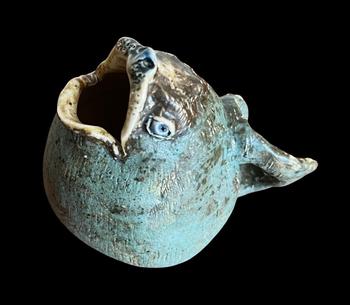featured item

outstanding quality antique victorian cranberry glass oil... Read more
Dealer of the month A D antiques from Chipping Camden
Posted by Iain Brunt on 19/07/2022
Whilst Alison started her career as a generic antiques dealer (or more accurately a bric a brac trader at car boot sales), she was quickly drawn to the British Art Pottery Movement. Over 25 years she has carved out a niche as the leading International antiques dealer in the field.
The appeal comes as much from the social and political dimension that inspired the manufacturers, as the aesthetic quality and originality of the ceramics.
The designers and factories of the era were pushing the boundaries of creativity, chemistry and design. Many of these studios were actively rebuking the machine age and supporting the social philosophers of the day who were proposing the return to local crafts, the dignity of the worker and the movement away from elaborate ornamentation to simpler lines and design.
Typically, local labour and raw materials were utilized, womens’ artistry celebrated, and artists were paid a “living wage”. One of the studios that worked most closely to these principles was Conrad Dressler and Harrold Rathbone’s Della Robbia Pottery where a community of artists was formed and the factory employed artists such as “Shirley” who, as a paraplegic, had profound disabilities and painted with his mouth. These communities were replicated around the UK with numerous Guilds and Societies along with Progressive Art Schools promoting Art and Design and also the welfare of the Crafts People.
Whilst it would be fair to say that the factories that upscaled production such as Moorcroft and Doulton enjoyed commercial success, the smaller communities, whilst promoted by Retailers such as Liberty and Morris & Co. and winning notable awards in the Grand exhibitions of the time (notably the Franco British Exhibition of 1908,) failed to thrive commercially. Their socio-economic principles contributed to their lack of commercial success as the cost of production was so high.
There are many fascinating stories that are associated with the period: the “race” of the studios to develop the flambe glaze (where Doulton were said to have a “secret” flambe kiln where only a handful of workers were allowed access), the eccentricities of the Martin Brothers with stories of fatal fires, in-house fighting, ceramics stored under the floorboards and ultimately the mental health demise of two of the brothers and commitment to the sanitorium, and the claim that William Howson Taylor, the founder of the Ruskin Pottery, took the glaze recipe for his high-fired pottery literally to the grave.
These idiosyncratic stories combining both charm and the macabre, along with designs that are around 120 years old, yet still timeless, that have contributed to the current popularity and exponential growth of the British Art Pottery Movement over the last two decades. Rarely a year passes by where a new ceiling isn’t pushed through in the commercial value of a factory and the Global Antiques Market just continues to evolve and find new and enthusiastic collectors.




